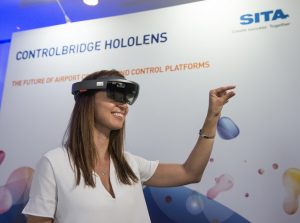A new world of mixed reality is emerging and SITA Lab, the research arm of air transport IT provider SITA, is exploring its potential for airlines and airports. Today it released early results of research carried out with Helsinki Airport using Microsoft HoloLens to analyse and manage airport operations in a mixed reality environment.
SITA worked with Helsinki Airport to use HoloLens to reproduce the airport operational control center (AOCC) in this mixed reality environment.
For this project SITA Lab used a feed from SITA’s Day of Operations technology, which is used by Helsinki Airport, and presented a new way to visualize and interact with the airport’s operational data including aircraft movement, passenger movement and retail analytics. Wearing the HoloLens, the operators had a set of screens meshed into a 3D view of the airport allowing them to correlate events from the data dashboards with an immersive real-time model of the airport.
Jim Peters, SITA CTO and head of SITA Lab, said: “Mixed reality, which combines augmented and virtual reality, is more than a new interface, it is a new way of looking at the world and allows things to be done in a new way. It enables digital and physical data to exist together. Our early research shows that there are potential uses for airlines and airports – for operations, maintenance and training. We need to learn how to interact in this new environment. In the same way that we moved from computers to smartphones and voice recognition, now we can go beyond the screen.”
The SITA Lab project interfaced into multiple data sources at Helsinki Airport to create the unique view of the ever-changing operations throughout the day. This included passenger real-time location and historic density data; aircraft position data; gate information; flight status information; security wait times and retail dwell times, segmented by passenger.
SITA Lab’s early research results show that unlike virtual reality, the mixed reality experience tends not to make people feel disorientated or nauseous. The HoloLens device itself has proven easy to learn and has a good battery life and doesn’t suffer from over-heating issues.
While the technology shows potential, SITA Lab points out it is early days and before enterprise use at airports issues of weight, size and durability will need to be addressed. Users must also learn how to interact in this new environment to maximise its benefits.





